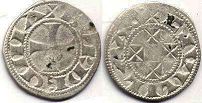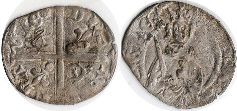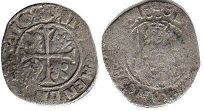Coins of Aquitaine - catalog with values
Duchy of Aquitaine
denier
William X the Saint (1127-1137)

denier no date
silver
BVRDEGVLA
CVILIEMO
Coin value ~ 25-35 USD
Edward, the Black Prince (1362-1375)

hardi (3 denier) no date
silver
PRIEPS AQTARE
ED P CIT REGI AGEL
Coin value ~ 40-60 USD
Charles II Duke of Berry (1469-1472)

hardi (3 denier) no date
silver
SIT NOMEN DNI BENEDICTI
KAROLVS DVX AQVITANI
Coin value ~ 40-60 USD
Other coins of French Feudalist
Costs of Aquitaine coins in this catalog approximate and indicated specifically for the coin shown in the picture.
I do not buy or sell coins - this is just a catalog.

